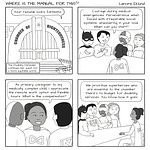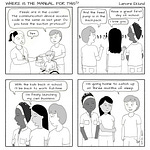
Welcome to the first edition of our new format (announced May 7)! This issue features The 19th’s reporting on the significant impact of caregiving costs on women’s lifetime earnings — a Department of Labor report that does not include care for adults with disabilities, but is interesting nonetheless. We also take a look at a piece from The New Yorker on parents’ ongoing struggle for a “free appropriate public education” for students with disabilities. Finally, NorthJersey.com has a piece on legislation to require a safety plan for students whose disabilities make it difficult to “run, hide or fight” during a mass shooting or other evacuation event.
As an aside: Thank you so much for still being a subscriber. I’m kind of amazed that you all stuck around! I would love to feature your photos in upcoming editions, so please feel free to reply to this email with one or two so we can continue to show the world what medical parenthood is really like. Thanks!
Medical Motherhood’s news round up
Snippets of news and opinion from outlets around the world. Click the links for the full story.
• From The 19th: “Caregiving costs women nearly $300,000 in lost pay over their lifetimes, Department of Labor finds”
The cost of caregiving on women’s lifetime earnings now has a number: $295,000.
A new report released Thursday by the Department of Labor projects how caregiving for children and parents affects women over the course of their careers, eating into their retirement savings and costing them wages and promotions.
The research projected the lifetime employment costs brought on by unpaid family care for women born between 1981 and 1985, now entering their early 40s, who have already taken on care for their children and will likely care for their parents, parents-in-law and spouses. The estimate is adjusted for inflation and is in 2021 dollars.
[…]The numbers are still very likely an undercount, the Women’s Bureau said. Because of limitations in the data, the research excludes care for adults with disabilities and caregiving costs unrelated to employment, such as the cost of day care and the emotional impact of caregiving.
Of the $295,000 figure, 80 percent is attributed to lost earnings due to caregiving and 20 percent is lost retirement income as a result of lower wages. The majority of the loss in wages comes from caring for children. Care for other adults totals only 15 percent of the costs, researchers found, because women are less likely to reduce their employment to provide it.
[…]The impacts are particularly outsized for Latinas, who are more likely to have more children and work in low-paying jobs with very limited flexibility, the report found. Less pay also means there are few child care options — the average annual cost of child care in the United States is nearly $11,000, which is out of reach for many Latinas. Without access to care, Latinas see their lifetime earnings slashed by 19 percent, the most of any racial group. That figure is 8 percent for Black mothers, 15 percent for White mothers and 14 percent for other groups [….]
• From The New Yorker: “The Parents Who Fight the City for a ‘Free Appropriate Public Education’”
[…]New York City’s public-school system has roughly a million students; about a hundred and eighty-one thousand of them have I.E.P.s, and there are thousands of Carter cases pending at any time. […Carter cases refer to lawsuits in which the family sues a public school district for tuition to a private school that can meet their child’s educational needs…] Because federal law requires that I.E.P.s be reviewed annually, families typically must file due-process complaints for tuition reimbursement every school year, which puts additional strain on the system. If, say, a mother prevails in arguing that her autistic first grader is appropriately placed at a private elementary school, she may still have to retain an attorney, front tuition fees, and await an impartial hearing for second, third, fourth, and fifth grade.
Lately, the number of New York City’s Carter cases has soared. Last fiscal year, the [Department of Education or] D.O.E. spent nine hundred and eighteen million dollars related to due-process claims, which, in inflation-adjusted dollars, was more than double what it spent in 2015 and more than four times what it spent in 2010. (Roughly one in every forty dollars that the D.O.E. spends is related to due-process claims.) The increase was driven by the coronavirus pandemic and the prolonged school shutdowns that followed—many special-education students regressed while in isolation and could not meaningfully access support services through a Zoom screen. Meanwhile, the crisis of covid-19-driven teacher burnout, which caused high rates of turnover and attrition, hit the special-education field hardest.
[…]During her stint as a cosplay attorney, and in her years of teaching, Emily told me that she has seen many violations of federal education standards that had nothing to do with lack of competence or good intentions but, rather, a lack of resources. The principals, psychologists, teachers, and social workers who were tasked with conceiving an I.E.P. did not have the funding, the training, the classroom space, or the credentialled colleagues to put the document into action. But those limitations are not a mitigating factor under I.D.E.A. “It is against the law to restrict your offerings based on what you have available in your school building—but, realistically, a lot of schools do that,” Emily said.
Many—perhaps most—due-process claims circle around this fiscal void. Rebecca Shore, of Advocates for Children, told me, “It shouldn’t be a matter of, ‘Well, we have no providers, so we can’t provide this service.’ It should be, ‘There are no providers—what are the reasons for that, and how do we come up with a solution?’ ” She went on, “The D.O.E. needs to take whatever steps are necessary to make these into jobs that people actually want to do.” In 2021, a salaried paraprofessional who shadowed a child with physical or behavioral challenges in school, for example, made between twenty-eight and forty-four thousand dollars per year. When support services such as speech or occupational therapy are not available at school, the D.O.E. offers vouchers that parents can use for approved private providers, but most therapists don’t accept them, owing to the low rates of compensation and long delays in receiving the money. “So one very simple solution is for the D.O.E. to pay more and pay quicker,” Shore said.
[…]“One of the most frustrating things is that when people talk about inclusive education, they don’t mean kids like Travis,” [Travis’ father] Dan told me at the playground, as we followed the kids toward the basketball courts. At one point, the family was deep into the application process at a private school where, Dan said, “all over their Web site is ‘inclusive, all kids.’ They said, ‘We would love to be part of Travis’s story.’ And then they see the I.E.P. and they learn all the details, and they’re, like, ‘Well, actually, we’re not set up to deal with a kid like this.’ ” The options, Dan said, “are either very lockdown-prison-feeling-type things, or a place where you’re taking a real risk, because the school will not deal with aggressive behavior.”[…]
• From NorthJersey.com: “Left behind in school evacuations, students with disabilities demand more protection in NJ”
With mass shootings on the rise nationwide, local school officials are confronting a unique challenge for one of their most vulnerable populations: how to ensure the safety of students with disabilities.
In New Jersey, that has prompted new legislation ordering districts to take the needs of students into account, amid tales of children left at the top of staircases or told to hide on their own.
Willingboro's Kevin Nunez, whose cerebral palsy necessitates a wheelchair, is 35. But he still remembers the fear of waiting by himself two decades ago while his fellow Bridgewater-Raritan Regional High School students evacuated without him during shooter drills.
“When I was in school, my evacuation plan was to wheel myself into the ladies’ bathroom, pull into the handicapped stall, which was the only place big enough for my power wheelchair, and turn around with my back to the door," Nunez, the vice chairman of the state's Council on Developmental Disabilities, recalled in an interview.
"They told me that if a shooter came in, the bullets would have to go through the metal door and my wheelchair before they hit me. I was told to wait there, alone, in the dark."
[…]the New Jersey Council on Developmental Disabilities adopted a white paper outlining emergency preparedness concerns that came out of a summit it hosted in 2017. Educators, school administrators, advocates and emergency personnel came together to discuss how to develop more inclusive emergency plans.
The council recommended that students with disabilities participate in emergency plans and drills tailored to their needs. Parents, educators and first responders should collaborate with disability advocates, and the plans should be evaluated regularly. Training should include all school staff across disciplines.
A bill in Trenton, S2057, would require districts to amend emergency plans to include students with disabilities in monthly fire and security drills. It would also mandate staff training on accommodating disabilities. A law enforcement officer would have to be present for at least one drill per school year to assess the procedures.
The legislation would also require emergency planning for individual students with disabilities to be documented in their health care plans, 504 plans and Individualized Education Plans.
The bill has passed the state Assembly and is scheduled for a vote in the state Senate on May 22, according to the office of state Sen. Shirley Turner, who co-sponsored the legislation with fellow Democratic state Sen. Linda Greenstein. […]
Medical Motherhood brings you quality news and information each Sunday for raising disabled and neurodivergent children. Get it delivered to your inbox each week or give a gift subscription. Subscriptions are free, with optional tiers of support. Thank you to our paid subscribers!
Follow Medical Motherhood on Facebook, Twitter, TikTok, Instagram or Pinterest. The podcast is also available in your feeds on Spotify and Apple Podcasts. Visit the Medical Motherhood merchandise store.












